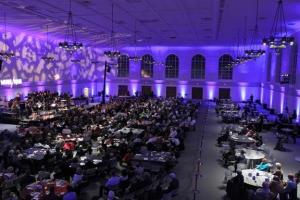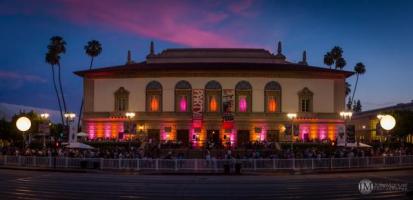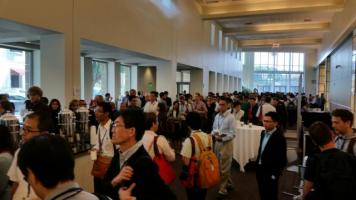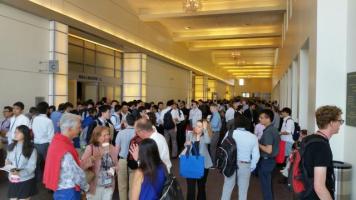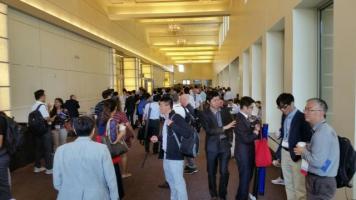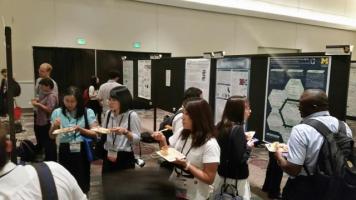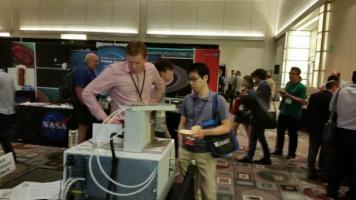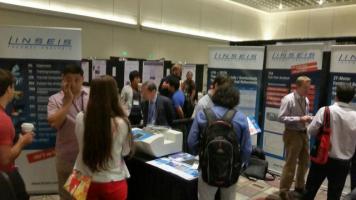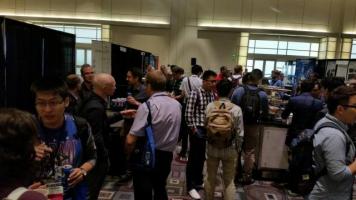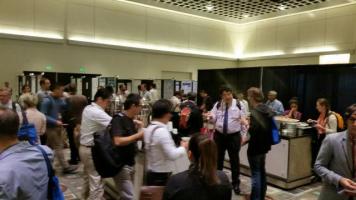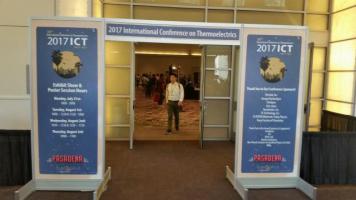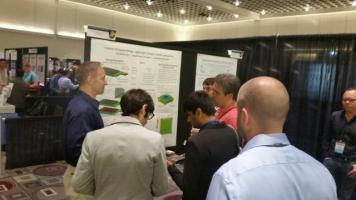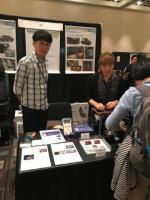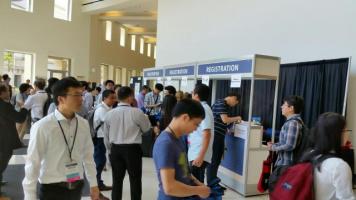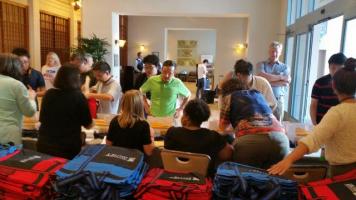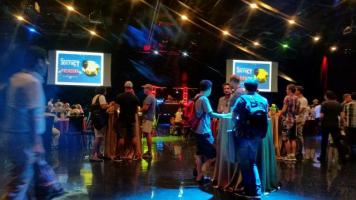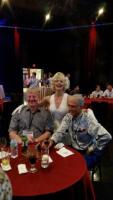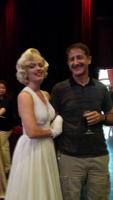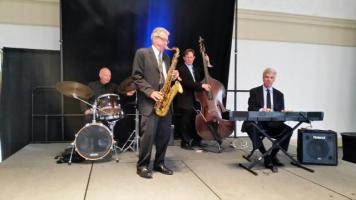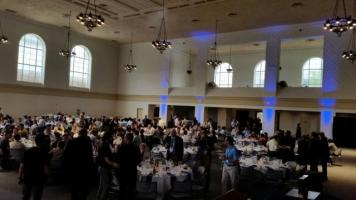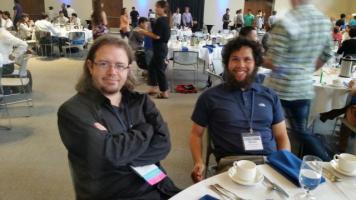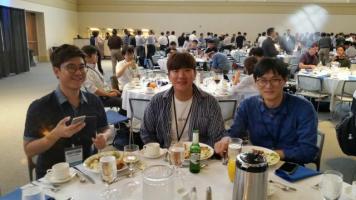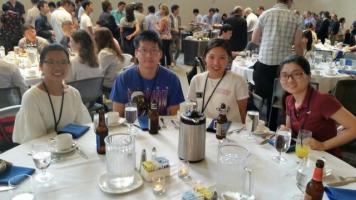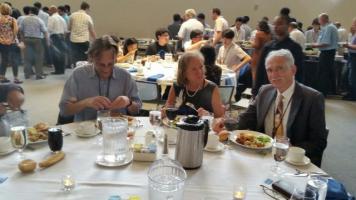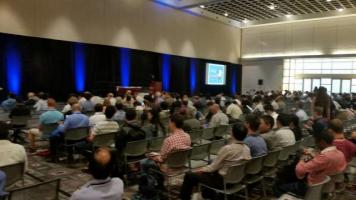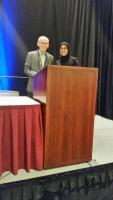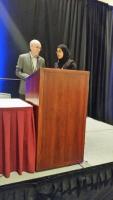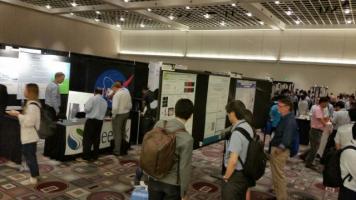News Category:
Widespread use on the horizon
Thermoelectrics conference breaks all records
From 26th to 30th July, 2009, nearly 600 experts from 40 different countries met in Freiburg for the by far greatest thermoelectrics conference of all times. The 28th International / 7th European Conference on Thermoelectrics yielded important results, e.g., in the discussion of how thermoelectric generators can be further improved. The path leading to widespread use of waste heat recycling is clearly laid out for thermoelectrics.
In his opening speech at the conference, Baden-Württemberg’s minister of economic affairs, Ernst Pfister, emphasized the economic and environmental benefits of thermoelectrics in particular. “New technologies for the utilization of unused heat fractions at least in part are in dire need”, Pfister said in Freiburg, alluding to the fact that more than 60 percent of all consumed fossil primary energy are dissipated unused as heat energy. According to Pfister, as one of the most promising technologies enabling direct conversion of heat into electricity, thermoelectrics could contribute greatly to more efficient energy handling.
Apart from the conference host, Fraunhofer IPM, both the International and the European Thermoelectric Society can look back on a most successful week. Attracting an attendance of nearly 600, the event has grown in size and relevance in a way that would have been considered impossible just a few years ago. Around twice the last year’s number of experts took the opportunity to exchange views with their colleagues. And the international guests were not only impressed by the conference’s scientific part but also by its diverse social program. The event started with a reception hosted by the City of Freiburg in the Historic Merchants’ Hall on the Münster square. Halfway through the conference, an excursion into the Black Forest was organized and a gala dinner was held in the concert hall.
Some highlights in detail:
- General remarks: Similar to former ICT/ECT conferences, the majority of contributions concerned material- and also science-related topics. Trends were obviously “nanoscale” thermoelectrics and so called high-temperature materials, both with more than 100 contributions.
Due to the closely packed program with three parallel sessions, only two plenary talks were scheduled. Their topics “Thermoelectric goes automotive” (G. Buschmann, IAV GmbH, Berlin, Germany) and “Thermoelectric effects in heterostructure nanowires” (H. Linke, Lund, Sweden) elucidated clearly the wide and interdisciplinary range of thermoelectrics. Linke presented their efforts of heterostructuring nanowires as model systems to understand how electronic properties and phonon flow in such designed structures can be used to optimize thermoelectric behavior. He demonstrated that quantum-dot embedded nanowires show a huge electronic ZT much larger than one (ignoring phonon-mediated heat flow). In a subsequent talk, D. Cahill, however, asked “Do embedded nanodots make better thermolectrics?” and gave interesting and critical comments based on the results of his time-domain thermoreflectance method to determine cross-plane thermal conductivity. It is worth to read related upcoming papers in detail.
The 18 invited presentations covered, on one hand, all currently important branches of thermoelectrics and tried to open up thermoelectric research to new aspects on the other. In his talk entitled “Ionic thermopower: thermocells with mobile ions” (J. Janek, Giessen, Germany) J. Janek gave an introduction to ionic thermocells and how they function. In ionic thermocells, ions serve as charge carriers instead of n- or p-type charge carriers. They can reach Seebeck values up to 1000 µV/K, having a ZT of about 0.24. Ionic cells show a demixing effect in temperature gradients, with cobalt ions migrating to the cold side and magnesium ions migrating to the hot side. In “Thermoelectrics – Impacts on environment and sustainability” (A. Patyk, Karlsruhe, Germany), A. Patyk presented the first comprehensive and detailed study on resource availability, specific energy consumption of thermoelectric device production and specific energy and CO2 savings using thermoelectric energy conversion.
C. Drasar’s (Pardubice, Czech Republic) overview “Doping and defect structure of tetradymite-type crystals" showed that after more than 50 years even for the main thermoelectric material – the V2VI3-compounds – a complete and systematic interpretation including all doping effects is still under research.Among the preparation methods for thermoelectric materials and devices, spark plasma sintering demonstrated its research and manufacturing capabilities for advanced thermoelectric materials with 45 contributions (Y. Grin, MPG Dresden, Germany).
With regard to material development, the oxides were presented by A. Weidenkaff (Dübendorf, Switzerland) and R. Funahashi (Ikeda, Japan). Power generation up to 0,4W/cm2 has been achieved recently.C. Boulanger (Metz, France) presented an excellent overview about “Electroplating: an opportunity for thermoelectric materials” with the conclusion that meanwhile encouraging results for high-quality electroplated thin film (up to tenths of µm) are achievable. The widespread applications in cooling and, in particular, autarkic sensor systems combined with wireless data transfer for devices based on “sputtered thin films” (few tenths of µm) were discussed by J. Nurnus (Micropelt, Freiburg, Germany). Especially autarkic sensor systems are regarded as a huge upcoming thermoelectric market.
The relatively small number of application papers may be due to the probable reluctance of industry to disclose activities which they consider sensitive. Nevertheless, all application sessions were overcrowded.
- Automotive waste heat recovery: Based on vehicle tests with thermogenerators, automotive industry predicts that efficient thermogenerators in conjunction with sophisticated power management will be able to improve fuel efficiency by around five to seven percent. Diesel and petrol engines make different demands on waste heat recycling, however. This should be taken into account when optimizing the respective parameters such as, e.g., compression or exhaust gas temperature, G. Buschmann IAV, Berlin, Germany.
- Materials: Improving material efficiency and substitution of tellurium-containing and therefore very expensive materials continue to be among the highest priorities. It should be mentioned that the silicide sessions were overcrowded, due to the assumption that silicides are one of the most promising candidates for high-temperature materials.
Gerda Rogl (Wien, Austria) presented a lot of new and encouraging results on the skutterudite compound family. - Manufacturing: So-called spark plasma sintering (see also above) – a short-time sintering method similar to hot pressing – is increasingly gaining centre stage for the development of advanced thermoelectric materials and even complete modules but also for volume production of thermoelectric devices.
- Exhibition: A prototype car fitted with a thermoelectric generator for waste heat recovery and presented by the Berlin-based company IAV GmbH was one of the highlights / eye catchers of the exhibition accompanying the event. The Freiburg-based company Micropelt, a spin-off of a Fraunhofer IPM development, presented commercial products for cooling applications and for energy self-sufficient sensor equipment. Apart from waste heat recovery, generating minute amounts of energy for energy-independent sensors – e.g., for monitoring safety relevant parts such as aircraft shells – constitutes another major application for thermoelectrics.
Final remarks
In recent years, the development of thermoelectric materials has advanced tremendously with the result that widespread use of this technology can be expected in just a few years time from now. Improving energy efficiency is a global issue. And thermoelectrics will contribute its share to that.
Assisted by the Federal State, Fraunhofer IPM is planning to establish a research association, “Thermoelectrics Baden-Württemberg”, in Freiburg. This association will further accelerate material, module, and systems development and add to the strength of the Location of Germany and, especially, Baden-Württemberg. “Already, Freiburg is an established factor in thermoelectrics”, says Harald Böttner, Chairman of the international Conference ICT2009 in Freiburg. “We are receiving a lot of acceptance from all sides. And politics are also willing to help us along our way.” This, among other things, includes building a thermoelectrics competence centre on the Fraunhofer IPM’s site. Therefore, Freiburg thermoelectrics can look to the future with great expectations and high motivation.
Host – Fraunhofer IPM
The Fraunhofer Institute for Physical Measurement Techniques IPM develops and implements turn-key optical sensor and imaging systems. In the field of thermoelectrics, the institute occupies a leading position in materials research, simulation, and systems design. In thin film technology, Fraunhofer IPM works on materials, production processes, and systems; semiconductor gas sensors form a further field of activity. ->thttp://ww.ipm.fraunhofer.de
Your contact:
Dr. Harald Böttner
Head of Thermoelectrics and Integrated Sensor Systems department
Phone +49 761 8857-121
harald.boettner@ipm.
Fraunhofer Institute for Physical Measurement Techniques IPM
Holger Kock
Press and public relations
Heidenhofstraße 8
79110 Freiburg
Phone +49 761 8857-129
Fax +49 761 8857-224
holger.kock@ipm.fraunhofer.de
http://www.ipm.fraunhofer.de
Welcome reception of the Lord Mayor of Freiburg
|
|
|
|
H. Böttner opening the Conference at the Lord Mayor Welcome Reception in the Historic Merchants’ Hall on the Münster square |
Welcome reception in the Historic Merchants’ Hall on the Münster square |
|
|
|
|
Young women in traditional costumes of the Black Forest offer special Black Forest schnapps |
ITS president Thierry Caillat (second from left) and former ITS president J.-P. Fleurial (right) at the welcome reception |
Concert Hall Freiburg, Germany
|
|
|
|
ICT/ECT 2009: flags in front of the Concert Hall |
Concert Hall Freiburg, Germany |
|
|
|
|
ICT/ECT 2009 banner in front of the Concert Hall |
Conference members visiting the accompanying exhibition |
Start of ICT/ECT 2009 Monday 27th July
|
|
|
|
VW Golf (IAV) equipped with a thermogenerator. |
Prof. Wagner opening the conference, Monday 27th July 2009. |
The green people
|
|
|
|
The conference assistants “the greens” |
Raimar Rostek, backbone of the conference and head of the “green people” at the gala dinner |
Titisee excursion
|
|
|
|
Excursion of all participants to Titisee |
Black Forest cake and black forest dance group
|
|
|
|
|
Black Forest cookoo clocks
|
Black Forest cake and black forest dance group
|
Banquet
|
|
|
|
J. Goldsmid and ITS president T. Caillat presenting the Goldsmid Award to Han Li |
The young investor award was given to Jong-Soo Rhyee, Tom Nilges, and Jean-Numa Gillet (in the picture: J.-S. Rhyee) |
|
|
|
|
Tom Nilges and ITS president T. Caillat with the ITS 2009 Scientific Award |
Jean-Numa Gillet and ITS president T. Caillat with the ITS 2009 Scientific Award
|
|
|
|
|
Rene Beigang from Fraunhofer IPM: the magic show |
In the small hours, only a few were left: the ICT/ECT organization team at the banquet |





















